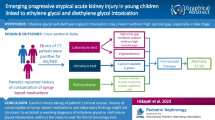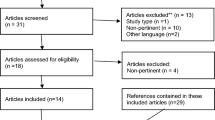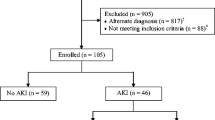Abstract
Background
In 2008, several Nigerian children developed acute kidney injury (AKI) after ingesting teething syrup contaminated with diethylene glycol (DEG). Because there are limited diagnostic facilities in resource-constrained countries, this study investigated whether AKI associated with DEG could be identified by other means.
Methods
This was a multicenter study. Information was obtained from hospital records. Clinicopathological features of all children with AKI over a 6-month period were reviewed.
Results
Sixty (50.4%) of 119 children ingested “My pikin” teething syrup. Compared to children who had not ingested it, they were significantly (p < 0.05) younger (11.95 vs. 31 months), more were anuric (98.3 vs. 74.6%), hypertensive (84 vs. 52%), had severe metabolic acidosis (46.7 vs. 20.5%), and died (96.6 vs. 71.2%). They developed increasing metabolic acidosis and multiorgan dysfunction despite peritoneal dialysis. Late presentation, financial difficulties, inadequate facilities for toxicology, and hemodialysis complicated management.
Conclusions
Identifying AKI associated with DEG is difficult. Detailed drug history, increasing metabolic acidosis, and multiorgan deterioration despite peritoneal dialysis should arouse suspicion. Simple diagnostic tests need to be developed and facilities for hemodialysis of infants and financial support provided. Recurrences can be prevented by creating awareness, improving manufacturing practices, field-testing of drugs, and international monitoring of pharmaceuticals imported for manufacture.

Similar content being viewed by others
References
Nigerian National Agency for Food and Drug Administration and Control (NAFDAC) (2009) Brief on contaminated “My Pikin” baby teething mixture”: report of investigation and regulatory action by NAFDAC Pharmcovigilance. (FDIC) News 3
Bonati M (2009) Once again, children are the main victims of fake drugs. Arch Dis Child 94:468
Abubakar A, Awosanya E, Badarau O, Haladu S, Nguku P, Edwards P, Noe R, Teran-Maciver M, Wolkin A, Lewis L, Nguyen M (2009) Fatal poisoning among young children form diethylene glycol-contaminated acetaminophen- Nigeria, 2008-2009. Morb Mortal Wkly Rep 58:1345–1347
Kraut JA, Kurtz I (2008) Toxic alcohol ingestions: clinical features, diagnosis, and management. Clin J Am Soc Nephrol 3:208–225
Barr DB, Barr JR, Weerasekera G, Wamsley J, Kalb SR, Sjodin A, Schier JG, Rentz ED, Lewis L, Rubin C, Needham LL, Jones RL, Sampson EJ (2007) Identification and quantification of diethylene glycol in pharmaceuticals implicated in poisoning epidemics: an historical laboratory perspective. J Anal Toxicol 31:295–303
Okuonghae HO, Ighogboja IS, Lawson JO, Nwana EJ (1992) Diethylene glycol poisoning in Nigerian children. Ann Trop Paediatr 12:235–238
Osinusi K, Sodeinde O, Ambe JP, Njinyam MN, Akang EEU (1991) Diethylene glycol poisoning in Nigerian children. Niger J Paediatr 18:87–93
Bogdanich W, Hooker J (2007) From China to Panama, a trail of Poisoned Medicine. The New York Times http://www.nytimes.com/2007/05/06/world/americas/06poison
Schep LJ, Slaughter RJ, Temple WA, Beasley DM (2009) Diethylene glycol poisoning. Clin Toxicol (Phila) 47:525–535
Calvary HO, Klumpp TG (1939) The toxicity for human beings of diethylene glycol with sulfanilamide. South Med J 32:1105–1109
Hanif M, Mobarak MR, Ronan A, Rahman D, Donovan JJ, Bennish ML (1995) Fatal renal failure caused by diethylene glycol in paracetamol elixir: the Bangladesh epidemic. BMJ 311:88–91
O'Brien KL, Selanikio JD, Hecdivert C, Placide MF, Louis M, Barr DB, Barr JR, Hospedales CJ, Lewis MJ, Schwartz B, Philen RM, St Victor S, Espindola J, Needham LL, Denerville K (1998) Epidemic of pediatric deaths from acute renal failure caused by diethylene glycol poisoning. JAMA 279:1175–1180
Bowie MD, McKenzie D (1972) Diethylene glycol poisoning in children. S Afr Med J 46:931–934
Singh J, Dutta AK, Khare S, Dubey NK, Harit AK, Jain NK, Wadhwa TC, Gupta SR, Dhariwal AC, Jain DC, Bhati R, Sokhey J (2001) Diethylene glycol poisoning in Gurgaon, India, 1998. Bull World Health Organ 79:88–95
Bogdanich W (2007). The Everyman Who Exposed Tainted Toothpaste, New York Times, October 1, 2007 http://www.nytimes.com/2007/10/01/world/americas/01panama.html
The New York Times (1985) Popular Wines found to hold toxic chemical. November 1 http://www.nytimes.com/1985/11/01/us/popular-wines-found-to-hold-toxic chemical.html
Rentz ED, Lewis L, Mujica OJ, Barr DB, Schier JG, Weerasekera G, Kuklenyik P, McGeehin M, Osterloh J, Wamsley J, Lum W, Alleyne C, Sosa N, Motta J, Rubin C (2008) Outbreak of acute renal failure in Panama in 2006: a case-control study. Bull World Health Organ 86:749–756
Cantarell MC, Fort J, Camps J, Sans M, Piera L (1987) Acute intoxication due to topical application of diethylene glycol. Ann Intern Med 106:478–479
Marraffa JM, Holland MG, Stork CM, Hoy CD, Hodgman MJ (2008) Diethylene glycol: widely used solvent presents serious poisoning potential. J Emerg Med 35:401–406
WHO Multicentre Growth Reference Study Group (2006) WHO child growth standards based on length/height, weight and age. Acta Paediatr Suppl 450:76–854
de Onis M, Onyango AW, Borghi E, Siyam A, Nishida C, Siekmann J (2007) Development of a WHO growth reference for school-aged children and adolescents. Bull World Health Organ 85:660–667
National High Blood Pressure Education Program Working Group on High Blood Pressure in Children and Adolescents (2004) The fourth report on the diagnosis, evaluation, and treatment of high blood pressure in children and adolescents. Pediatrics 114:555–576
Hossain M (1995) Other factors may have contributed to epidemic of renal failure. BMJ 311:950–951
Federal Ministry of Health Federal Republic of Nigeria (2005) National Anitmalarial Antimalarial Treatment Policy
Sherma J (2007) Analysis of counterfeit drugs by thin layer chromatography. Acta Chromatographica 19:5–20
World Health Organization (2005) Urinary Tract Infections in Infants and Children in Developing Countries in the Context of IMCI WHO/FCH/CAH/0511
Author information
Authors and Affiliations
Corresponding author
Rights and permissions
About this article
Cite this article
Akuse, R.M., Eke, F.U., Ademola, A.D. et al. Diagnosing renal failure due to diethylene glycol in children in a resource-constrained setting. Pediatr Nephrol 27, 1021–1028 (2012). https://doi.org/10.1007/s00467-011-2082-8
Received:
Revised:
Accepted:
Published:
Issue Date:
DOI: https://doi.org/10.1007/s00467-011-2082-8




